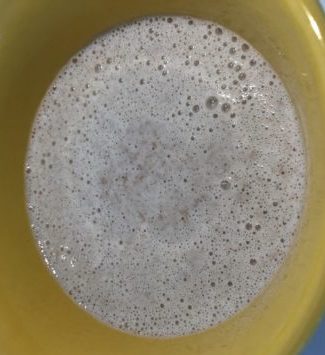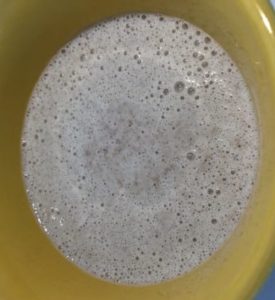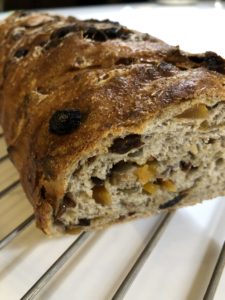Starting Sourdough
- At October 09, 2023
- By Roxanne Snopek
- In Baking, Roxanne Writes On
 0
0
Starting sourdough, yeah, it’s a challenge. But so worth it!
Making a sourdough starter isn’t hard. You mix equal parts flour (I used whole wheat) and water (bottled, so there’s no chlorine) in a bowl, cover it lightly with plastic wrap so nothing gets in it, but it can still “breathe” and then leave it. Stir it down once daily for three days and voila. You should end up with a yeasty, bubbling, warm mass of fermented grain that can be used in place of commercial yeast to make bread.
Why? You might ask. When you can buy perfectly good bread at the store?
If you like food (which I do) and you like the science of nutrition (ditto) and you’re a creative type up for a challenge, this is a fun one. I was looking for a fun challenge and I also get a little bent out of shape about how badly bread is maligned in current thinking. In fact, according to Michael Pollan, see earlier post, it’s not that bread is so bad for us. It’s that some bread as it’s made today is bad for us. Whole grain bread, made with minimal ingredients, and sourdough culture instead of fast-acting yeast, is a whole other ball game.
Grains have a natural protective shell that allow animals and birds to eat and then disperse still-viable seed that can then take root elsewhere, propagating the plant. Eating a bag of wheat won’t provide you with much bio-available nutrition.
Grind that wheat into flour and the nutrients become far more available. But still not great.
Enter the magic of fermentation. Introduce friendly bacteria in the form of sourdough starter to that mix of flour and water, give them time to work, and they break down that protective shell for us. The nutrients in the grain become far more digestible, providing a higher-quality food product.
Not to mention more delicious. Come back tomorrow to see what I baked.
Counter Culture
- At March 11, 2019
- By Roxanne Snopek
- In Baking, Life, Roxanne Writes On
 2
2
Counter culture… aka, the “thing” living in your kitchen….
As you may know, it’s been the Winter of Bread here in Chez Snopek. About a month ago, I watched a NetFlix documentary series called Cooked, based on the book by Michael Pollan. In the episode called “Air” he talked about bread. Well. If you know me AT ALL, you know I have a deep and abiding love of bread. Baking it, eating it, taking pictures of it, writing about it…
Talk about counter-culture.
With everyone so carb-conscious right now, bread is taking a real beating, so this episode was particularly interesting because it was talking specifically about fermented bread, ie: sourdough.
Which is a whole ‘nother story. Fermented breads, it turns out, are very different nutrition-wise. (Keep in mind, I’m talking about fully-fermented, mostly or all whole-grain breads.) The nutrients in the grain are more bio-available, the long fermentation process autolyzes the bran, making it more gut-friendly, and people with diabetes report that sourdough bread doesn’t cause the spike in blood sugar that regular bread does.
 My spidey-senses were way up.
My spidey-senses were way up.
I’ve experimented with sourdough before. I’ve done the “friendship bread” thing, but those are loaded with ingredients like instant pudding and sugar, not what I’m interested in.
This, as Michael Pollan describes it, is the real thing. Whole grain flour and water, left out at room temperature to colonize with natural yeasts and bacteria from the air, until it ferments into a culture that can transform a sticky mass of flour, water and salt into those crisp, tangy, crusty, chewy loaves we all love.

A culture. That sits on the counter.
Until it becomes this: sourdough fruit and nut bread. Yeah, baby. Now that’s worth getting up in the morning for.
Then I read more. Oh, there’s lots to read about sourdough. It’s an Internet rabbit hole that a baker like me could get lost in for day after delicious day, and I have. Stick with me and I’ll tell you about it. Or you could give one of these books a try.
I made my starter according to directions from The Il Fornaio Baking Book: Sweet and Savory Recipes from the Italian Kitchen. The fruit bread recipe came from Artisan Sourdough Made Simple: A Beginner’s Guide to Delicious Handcrafted Bread with Minimal Kneading
.




